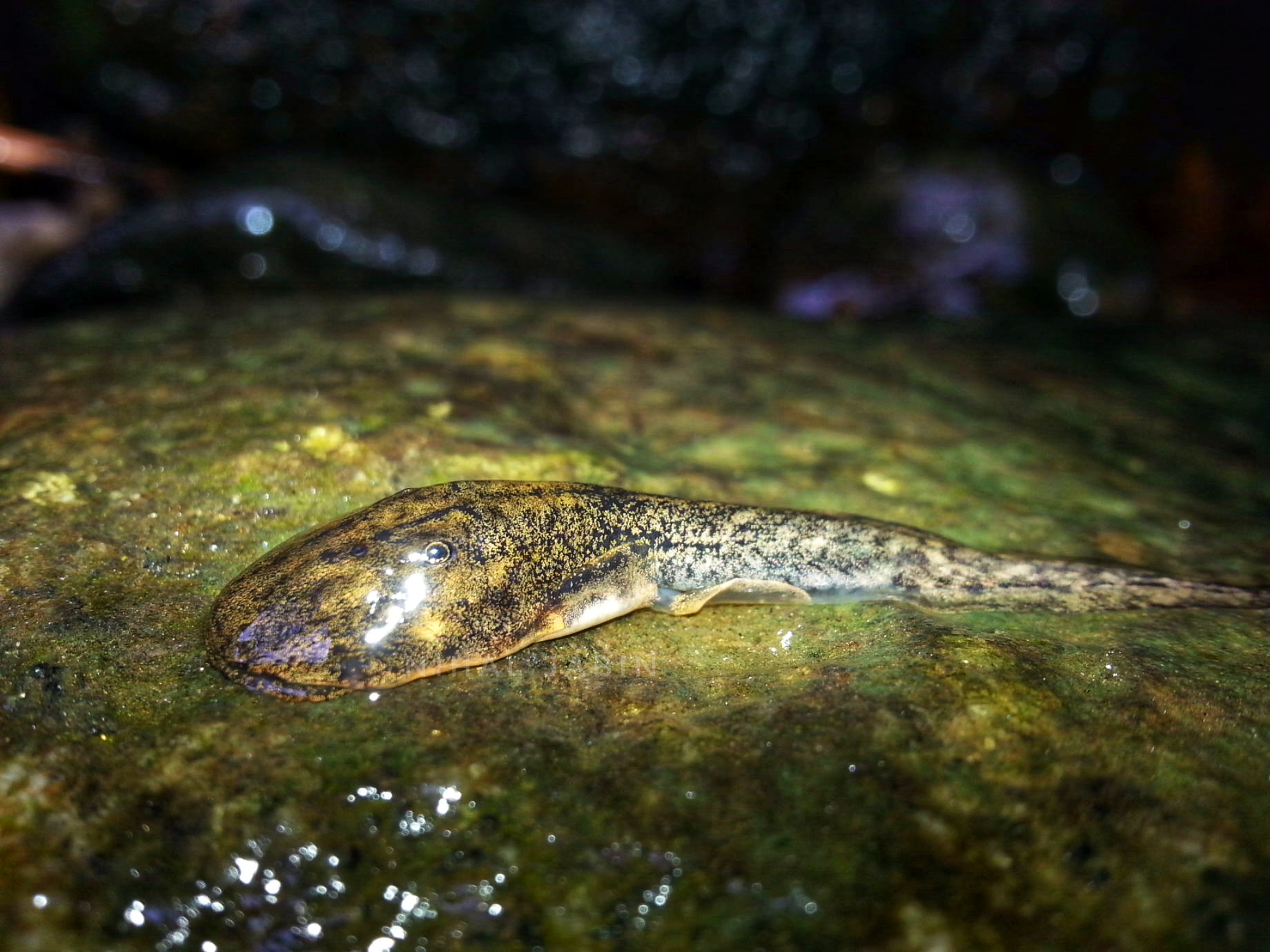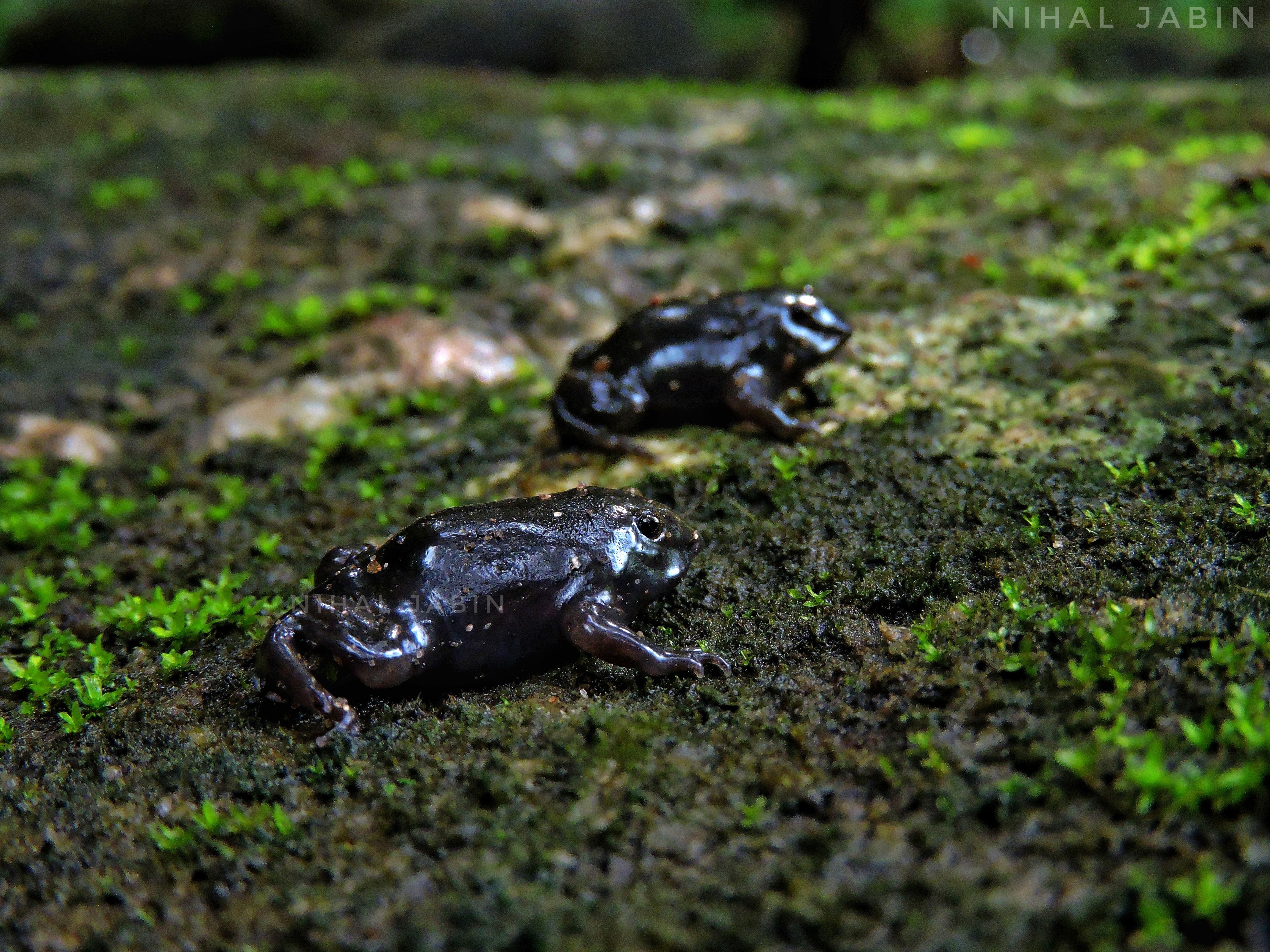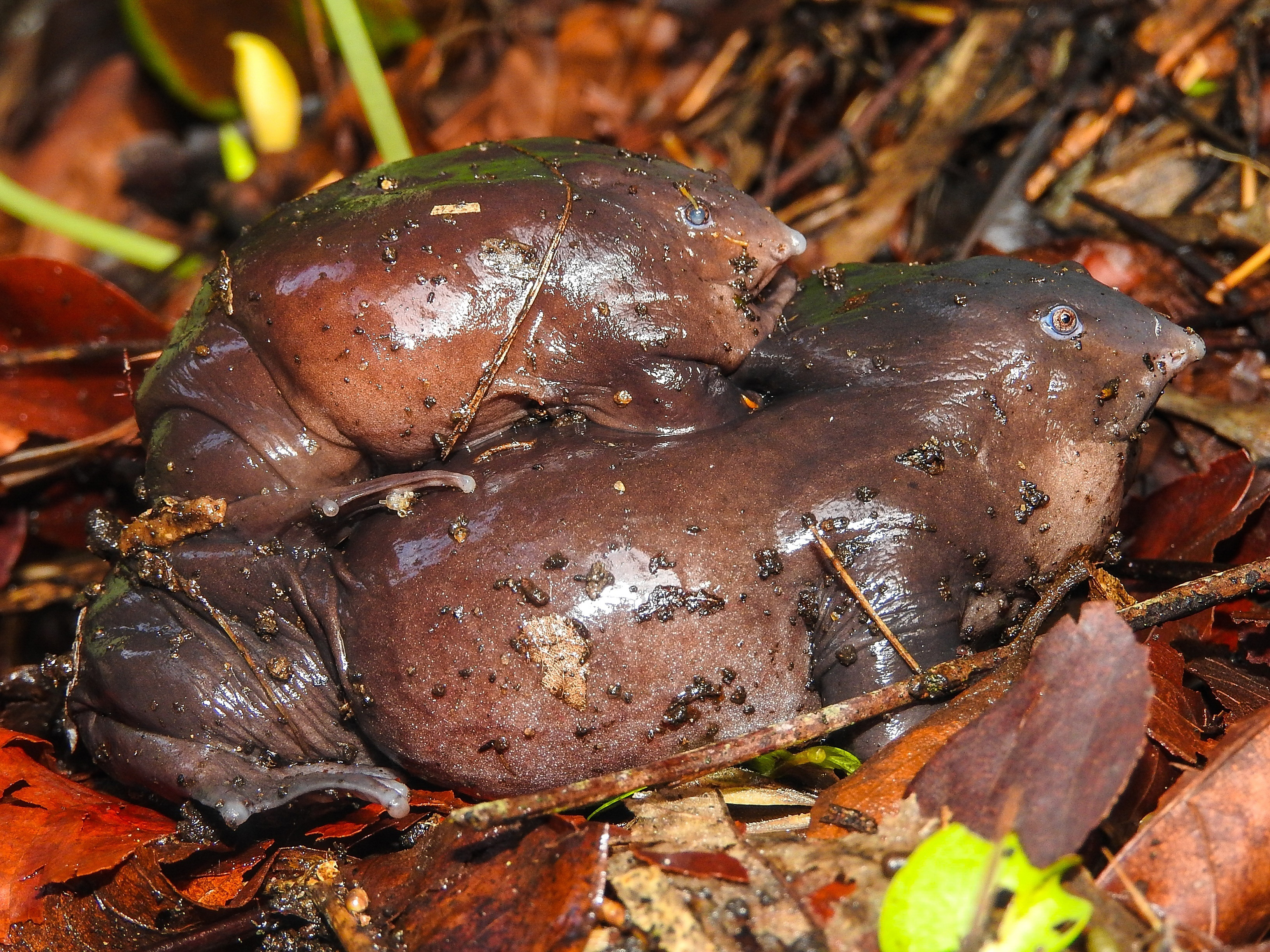Purple frog on:
[Wikipedia]
[Google]
[Amazon]
The purple frog (''Nasikabatrachus sahyadrensis''), Indian purple frog, or pignose frog is a


 Unlike many other burrowing species of frogs that emerge and feed above the ground, this species has been found to forage underground, feeding mainly on termites using its tongue and a special buccal groove.
In 2015, tadpoles of the species were discovered to be traditionally consumed by tribal communities.
The major threat to these amphibians in the Western Ghats of India is caused by the alteration of natural habitats by an ever-increasing human population, resulting in large areas being converted for settlement and agricultural use. Recent studies have shown frog utilization to be one of the major threats, which include the utilization of frogs for food, traditional medicine, research purposes, and pet trade has also been considered a major contributor to their decline. Tadpole-harvesting was prevalent in the monsoon season during July–September every year. The Nadukani-Moolamattom-Kulamaav tribal people have developed an indigenous method for collecting these uniquely adapted
Unlike many other burrowing species of frogs that emerge and feed above the ground, this species has been found to forage underground, feeding mainly on termites using its tongue and a special buccal groove.
In 2015, tadpoles of the species were discovered to be traditionally consumed by tribal communities.
The major threat to these amphibians in the Western Ghats of India is caused by the alteration of natural habitats by an ever-increasing human population, resulting in large areas being converted for settlement and agricultural use. Recent studies have shown frog utilization to be one of the major threats, which include the utilization of frogs for food, traditional medicine, research purposes, and pet trade has also been considered a major contributor to their decline. Tadpole-harvesting was prevalent in the monsoon season during July–September every year. The Nadukani-Moolamattom-Kulamaav tribal people have developed an indigenous method for collecting these uniquely adapted
Edge of Existence page on ''Nasikabatrachus sahyadrensis''
Continental drift and the Sooglossidae
AmphibiaWeb page on ''Nasikabatrachus sahyadrensis''
{{Taxonbar, from=Q311152 Endemic fauna of the Western Ghats Frogs of India Amphibians described in 2003 EDGE species Articles containing video clips Taxa named by Sathyabhama Das Biju Nasikabatrachidae
frog
A frog is any member of a diverse and largely carnivorous group of short-bodied, tailless amphibians composing the order Anura (ανοὐρά, literally ''without tail'' in Ancient Greek). The oldest fossil "proto-frog" ''Triadobatrachus'' is ...
species of the genus '' Nasikabatrachus''. It is endemic to the Western Ghats in India
India, officially the Republic of India (Hindi: ), is a country in South Asia. It is the seventh-largest country by area, the second-most populous country, and the most populous democracy in the world. Bounded by the Indian Ocean on the so ...
. Although the adult frog was formally described in October 2003, the juvenile form of the species
In biology, a species is the basic unit of classification and a taxonomic rank of an organism, as well as a unit of biodiversity. A species is often defined as the largest group of organisms in which any two individuals of the appropriate s ...
was described earlier in 1917.
History of the discovery
The species was described from specimens collected in the Idukki district ofKerala
Kerala ( ; ) is a state on the Malabar Coast of India. It was formed on 1 November 1956, following the passage of the States Reorganisation Act, by combining Malayalam-speaking regions of the erstwhile regions of Cochin, Malabar, South ...
by S.D. Biju from the Tropical Botanic Garden and Research Institute in Palode, India, and Franky Bossuyt from the ''Vrije Universiteit Brussel
The Vrije Universiteit Brussel (VUB) () is a Dutch and English-speaking research university located in Brussels, Belgium.The Vrije Universiteit Brussel is one of the five universities officially recognised by the Flemish government. listof all ...
'' (Free University of Brussels), in 2003. However, it was already well known to the local people and several earlier documented specimens and publications had been ignored by the authors in the 2003 paper that describes the genus and species.
''Nasikabatrachus sahyadrensis'' closest living relatives are considered to be the Sooglossidae, only known in the Seychelles, an island chain in the Indian Ocean.
Name
The scientific name ''Nasikabatrachus sahyadrensis'' is a Latinizedportmanteau
A portmanteau word, or portmanteau (, ) is a blend of wordsSanskrit
Sanskrit (; attributively , ; nominally , , ) is a classical language belonging to the Indo-Aryan branch of the Indo-European languages. It arose in South Asia after its predecessor languages had diffused there from the northwest in the late ...
() for "nose", Greek
Greek may refer to:
Greece
Anything of, from, or related to Greece, a country in Southern Europe:
*Greeks, an ethnic group.
*Greek language, a branch of the Indo-European language family.
**Proto-Greek language, the assumed last common ancestor ...
() for "frog", and Sahyadri, the native name for the Western Ghats which forms the purple frog's natural habitat.
One of its common names, the purple pig-nosed frog, also makes reference to the elongated morphology of its snout, which is well adapted to the acquisition of fossorial termites.
Description
The body of ''Nasikabatrachus sahyadrensis'' appears robust and bloated and is relatively rounded compared to other moredorsoventral
Standard anatomical terms of location are used to unambiguously describe the anatomy of animals, including humans. The terms, typically derived from Latin or Greek roots, describe something in its standard anatomical position. This position prov ...
ly flattened frogs
A frog is any member of a diverse and largely carnivorous group of short-bodied, tailless amphibians composing the order Anura (ανοὐρά, literally ''without tail'' in Ancient Greek). The oldest fossil "proto-frog" '' Triadobatrachus'' is ...
. Their flattened body assists them to cling to submerged rocks and boulders which essentially helps them fight strong currents, allowing them to remain near stream banks where they typically reside. Its arms and legs splay out in the standard anuran body form. Compared to other frogs, ''N. sahyadrensis'' has a small head and an unusual pointed snout. Adults are typically dark purplish-grey in color. Males are about a third of the length of females. The specimen
Specimen may refer to:
Science and technology
* Sample (material), a limited quantity of something which is intended to be similar to and represent a larger amount
* Biological specimen or biospecimen, an organic specimen held by a biorepository ...
with which the species was originally described was long from the tip of the snout to the vent. Tadpoles of the species had been described in 1917 by Nelson Annandale
Thomas Nelson Annandale CIE FRSE (15 June 1876, in Edinburgh – 10 April 1924, in Calcutta) was a British zoologist, entomologist, anthropologist, and herpetologist. He was the founding director of the Zoological Survey of India.
Life
The eld ...
and C. R. Narayan Rao as having oral suckers that allowed them to live in torrential streams. Suckers are also present in rheophilic
A rheophile is an animal that prefers to live in fast-moving water.
Examples of rheophilic animals
Insects
*Many aquatic insects living in riffles require current to survive.
*'' Epeorus sylvicola'', a rheophilic mayfly species ( Ephemeropter ...
fishes of genera such as ''Glyptothorax
''Glyptothorax'' is a genus of catfishes order Siluriformes of the family Sisoridae. It is the most species-rich and widely distributed genus in the family with new species being discovered on a regular basis. These species are distributed in the ...
'', ''Travancoria
''Travancoria'' is a small genus of hillstream loaches endemic to India.
Species
There are currently two recognized species
In biology, a species is the basic unit of classification and a taxonomic rank of an organism, as well as a unit ...
'', '' Homaloptera'', and '' Bhavania'', adaptations that are the result of convergent evolution
Convergent evolution is the independent evolution of similar features in species of different periods or epochs in time. Convergent evolution creates analogous structures that have similar form or function but were not present in the last com ...
. Some of these fishes co-occur with ''Nasikabatrachus'' tadpoles in the hill streams. Its vocalization is a drawn-out harsh call that sounds similar to a chicken clucking. Males of this species exhibit the unique behavior of calling from under a thin layer of soil. Some other burrowing frogs (''Myobatrachus gouldii
''Myobatrachus'' is a genus of frogs found in Western Australia. It is monotypic, being represented by the single species, ''Myobatrachus gouldii'', also known as the turtle frog. It has a small head, short limbs, and a round body, up to long.
...
'' and '' Arenophyrne rotunda'') are known to do this, but these frogs have also been observed to call from the surface, while ''N. sahyadrensis'' has not. The frogs may switch to headfirst burrowing due to their wedge-shaped skull and other shaped limbs.

Distribution
Earlier thought to be restricted to the south of thePalghat Gap
Palakkad Gap or Palghat Gap is a low mountain pass in the Western Ghats between Coimbatore in Tamil Nadu and Palakkad in Kerala. It has an average elevation of with a width of . The pass is located between the Nilgiri Hills to the north ...
in the Western Ghats, additional records have extended its known range farther north of the gap. The species is now known to be quite widely distributed in the Western Ghats, ranging from the Camel's Hump Hill Range in the north, all the way to the northernmost portions of the Agasthyamalai Hill Range in the south.
Ecology
The frog spends most of its life underground and surfaces only during themonsoon
A monsoon () is traditionally a seasonal reversing wind accompanied by corresponding changes in precipitation but is now used to describe seasonal changes in atmospheric circulation and precipitation associated with annual latitudinal osci ...
, for a period of two weeks, for mating. With few field scientists out in the field during the rainy season, the species was discovered and studied only in recent times. Males emerge to call beside temporary rainwater streams. They mount females and grip them (amplexus
Amplexus (Latin "embrace") is a type of mating behavior exhibited by some externally fertilizing species (chiefly amphibians and horseshoe crabs) in which a male grasps a female with his front legs as part of the mating process, and at the same ...
) along the vertebral column. Around 3000 eggs are laid in a rock pool and the tadpoles metamorphose
Metamorphosis is a biological process by which an animal physically develops including birth or hatching, involving a conspicuous and relatively abrupt change in the animal's body structure through cell growth and differentiation. Some insec ...
after around 100 days.

 Unlike many other burrowing species of frogs that emerge and feed above the ground, this species has been found to forage underground, feeding mainly on termites using its tongue and a special buccal groove.
In 2015, tadpoles of the species were discovered to be traditionally consumed by tribal communities.
The major threat to these amphibians in the Western Ghats of India is caused by the alteration of natural habitats by an ever-increasing human population, resulting in large areas being converted for settlement and agricultural use. Recent studies have shown frog utilization to be one of the major threats, which include the utilization of frogs for food, traditional medicine, research purposes, and pet trade has also been considered a major contributor to their decline. Tadpole-harvesting was prevalent in the monsoon season during July–September every year. The Nadukani-Moolamattom-Kulamaav tribal people have developed an indigenous method for collecting these uniquely adapted
Unlike many other burrowing species of frogs that emerge and feed above the ground, this species has been found to forage underground, feeding mainly on termites using its tongue and a special buccal groove.
In 2015, tadpoles of the species were discovered to be traditionally consumed by tribal communities.
The major threat to these amphibians in the Western Ghats of India is caused by the alteration of natural habitats by an ever-increasing human population, resulting in large areas being converted for settlement and agricultural use. Recent studies have shown frog utilization to be one of the major threats, which include the utilization of frogs for food, traditional medicine, research purposes, and pet trade has also been considered a major contributor to their decline. Tadpole-harvesting was prevalent in the monsoon season during July–September every year. The Nadukani-Moolamattom-Kulamaav tribal people have developed an indigenous method for collecting these uniquely adapted suctorial Suctorial pertains to the adaptation for sucking or suction, as possessed by marine parasites such as the Cookiecutter shark, specifically in a specialised lip organ enabling attachment to the host.
Suctorial organs of a different form are possess ...
tadpoles. Usually, about 2–5 individuals would participate in each harvesting event.
The Purple Frog growth also depends on the velocity of the water. When the velocity of water increased, there was a greater number of tadpoles than the lower velocity of water areas in both streams. The tadpoles also had constant activity in the streams as well. They also have a huge influence on the number of tadpoles in the environments they are in.
References
External links
*Edge of Existence page on ''Nasikabatrachus sahyadrensis''
Continental drift and the Sooglossidae
AmphibiaWeb page on ''Nasikabatrachus sahyadrensis''
{{Taxonbar, from=Q311152 Endemic fauna of the Western Ghats Frogs of India Amphibians described in 2003 EDGE species Articles containing video clips Taxa named by Sathyabhama Das Biju Nasikabatrachidae